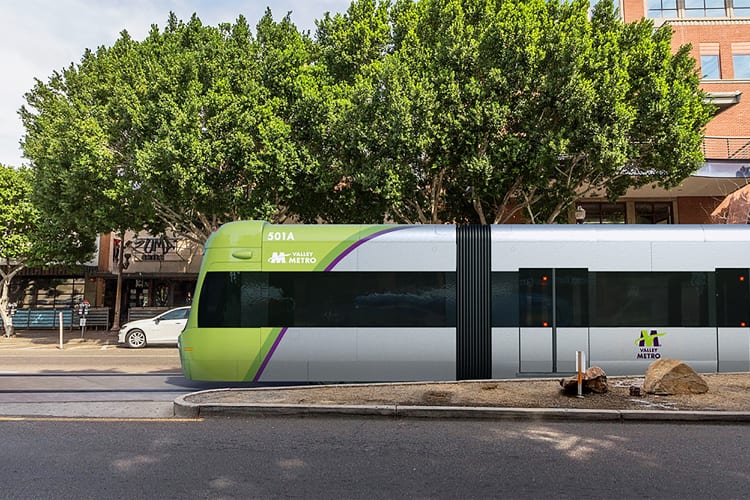As you round a curve on the eastbound Loop 202, a transformation comes into view.
Just over a decade ago, the Hayden Flour Mill and Silos and Hayden Butte were the most noticeable structures visible from west of downtown Tempe. Sure, there were other buildings visible, but nothing that could be considered a skyline existed in Tempe.
Today, downtown Tempe is looking more and more like an urban center, complete with tall buildings already standing and other large structures rising alongside them.
As an emerging population and commerce core, the downtown Tempe area, which includes the sprawling Arizona State University campus,
is faced with transportation issues that just couldn’t be solved by bus service alone.
“It’s clear that downtown Tempe is becoming a dense urban core, the second one in the Valley, so being able to move around as an individual is going to be really important,” said Morgan Olsen, executive vice president, treasurer and chief financial officer for Arizona State University. “If I’m an employer, I want to make sure my employees can get here, I want to make sure they have access to assets that are part of the larger area.”
Tempe and Valley Metro are teaming up on the Tempe Streetcar project to provide a solution to some of the transportation issues in downtown Tempe. The project is a circulator train that runs from the Marina Heights development on Rio Salado Blvd., through downtown Tempe on Mill Ave. and Ash Ave. and then around the bend as Mill Ave. turns into Apache Blvd. The Streetcar then stops at the Dorsey Lane light rail stop. There are two stops on the Streetcar line that provide access to the light rail line.
Streetcar vehicles are smaller than light rail cars and operate individually, not linked together like trains. The Streetcar operates on shared roadways with vehicle traffic stops, and there are 14 of them in the initial 3-miles of line, are similar to bus stops and occur more frequently.
Sunbelt Holdings, one of the developers of Marina Heights, was one of the business leaders supporting the Tempe Streetcar project from the beginning.
“It was really important to State Farm (which has room for 8,000 employees at Marina Heights) to have as robust of a transportation system as they could so that all of their employees did not have to be reliant on cars,” said Heidi Kimball, senior vice president at Sunbelt Holdings. “In good times, this is the time to do it. We all suffered through the 10-year recession, so now we’re enjoying some good times and it’s time to do these projects.”
The cost of the Streetcar project is an estimated $199 million. Much of that funding is coming from federal and regional sources, as well as city and state sources. There was, however, a shortfall of some $13 million. The development community in downtown Tempe stepped forward with a self-imposed tax of 10-cents per square foot for 20 years to close that funding gap.
“That’s a big tax,” Kimball said. “Like for Marina Heights, that’s $200,000 a year.”
Kimball said all of the major developers with projects in the area stepped up.
“It’s important that everybody participates so that no one is economically disadvantaged,” Kimball said. “We are constantly watching and vigilant to make sure that everyone plays.”
While the business community has been supportive of the project from the beginning, Arizona State University has also lent financial support, as well as vocal support. The Streetcar will offer ASU students alternative transportation options as they move about the campus and the surrounding community.
Work on the project began in July of 2017 with utility relocation and street work. The next phase was originally supposed to begin in 2019, but the installation of the track guideway was moved up to October when the Federal Transit Administration approved the project. The next phases, like the platforms, electrical systems will take place in 2019 and 2020, with the Streetcar scheduled to open in 2021.
Like the Valley Metro Light Rail system, the Streetcar will run along overhead electrical wires for most of the length of the route. However, in some areas, like through Mill Ave. and major intersections, there will be no overhead electrical wires to power the Streetcar.
“Tempe didn’t want those guide wires running down Mill Ave., so the trains will run on a hybrid system of battery power and then in some areas connect to the overhead wires to run the train and charge the batteries,” Kimball said. “It’s truly a unique system.”
How well the initial phase of the Streetcar is received will play a key role on whether or not Valley Metro will expand on it. Expansion plans would likely include extending the line along Rio Salado Parkway to Tempe Marketplace, then perhaps further west into Mesa with access to the Chicago Cubs spring training facility as well as Mesa Riverview.
“There are all of these things that can be connected and I know the City of Mesa has some interest in that regard,” said Olsen. “Anything you can do to create one very connected area, the more the better.
“The jewel that everyone is aligning along is Tempe Town Lake. Everything around that Tempe Town Lake, Rio Salado corridor is a candidate to be connected. I think the modern streetcar is a big piece to that.”




